Why is the reducer on a gas cylinder humming: what to do if the gas pressure regulator is noisy
The reducer is a mandatory component of the connection diagram for tanks with liquefied and compressed gas mixtures. They are installed on gas tanks, single cylinders and cylinder installations to stabilize and bring to standard values the gas pressure entering household equipment, welding torches and heaters.
It happens that during operation the device for ensuring stable pressure begins to make noise. We will tell you why the gearbox on a gas cylinder hums, and we will analyze why the sound appears. We will show you how to eliminate malfunctions in the operation of the device, which can be determined “by ear”.
The article we presented describes in detail the types of gas pressure stabilizers and their design features. Methods for restoring full functionality are given. Our recommendations will help home craftsmen cope with the repairs themselves.
The content of the article:
Gas pressure reducing devices
The need to use reducers is due to the difference in gas pressure in tanks intended for storing and dosed supply of gas to devices, and the operating parameters of the pressure required by these devices to perform their duties. When selecting fuel from a closed container, the pressure of the gas mixture must be reduced by a factor of ten or more.
Reducing the pressure of a liquefied or compressed gas mixture to operating characteristics is the main job of gearboxes.In addition, they automatically maintain the gas flow pressure within the limits required for normal operation. They also protect the gas tank from backlash, which is possible when the flame is activated.
Gas pressure is regulated using gearboxes. They can be configured to supply a gas medium with pressure parameters acceptable for literally any type of household and industrial equipment. Despite the extensive list of functions, all types of devices are structurally simple, and even work on a similar principle.
Types of gas reducers
In order to understand why the gas cylinder began to make noise, you need to study its structure. Let's figure out what types of gearboxes They are used in everyday life to regulate and stabilize the pressure of gas mixtures.
Classification is made according to the following grouping characteristics:
- Principle of operation. Gearboxes come in direct and reverse action. The first reduce the pressure in the tank itself and in front of the pipe connected to the gas equipment. The second - first reduce the pressure in the cylinder, then at the exit from it.
- Purpose. There are network (C), balloon (B) and ramp (R) devices. Network ones are mounted on gas supply pipelines, ramp ones are installed on cylinder installations, ensuring the supply of gaseous fuel in large volumes. Cylinder models are suitable for domestic conditions and one-time welding work.
- Type of gas being reduced. Pressure stabilizing devices are installed on all types of gas cylinders. To accurately select the required gearbox, they are painted in the colors of the cylinder. Red ones are produced for propane tanks, blue ones for oxygen tanks, and white ones for acetylene tanks.
- Regulation scheme. Setting the operating pressure parameters can be done and adjusted mechanically; such devices are single-stage (O) and two-stage (D). Gearboxes with pneumatic pressure selection are only single-stage.
- Connection. Reducers are manufactured for installation on cylinders with flammable and non-flammable gases. The devices are connected to oxygen containers with union nuts with a right-hand thread, and to cylinders with a propane-butane mixture - with nuts with a left-hand thread. The acetylene gearbox is connected using a clamp and a thrust screw.
Let's analyze and study the design with the principle of operation of gas reducers, traditionally used in everyday life to regulate the flow gas mixture to devices.
Design features and principle of operation
Summer residents and owners of small private houses use one of the most common gas reducer models in everyday life to supply gas to stoves, heaters and heating boilers: NZGA RDSG-1-1.2, popularly known as “frog”, or its analogues.
The single-stage model is extremely simple. The reduction is carried out by a membrane pressed from the outside by a spring. The membrane limits the path for gas movement through the cavity of the device so that a flow with a given volume and standard pressure enters the gas hose or pipe from the outlet.
If the pressure in the reducer cavity increases, the valve and washer connected to the membrane rise and cover the inlet. This is how pressure stability is ensured. And if it is necessary to change the operating pressure characteristics, these control elements are shifted, increasing or decreasing the cross-section of the inlet.

In slightly more complex devices, for example, in the FL92-4 PS model, reduction is carried out by a valve that limits the flow and thereby generates the pressure required by the devices.
The membrane in such devices does not directly participate in the formation of pressure, but only reduces the initial parameters. It itself is acted upon on one side by a gas flow, and on the other by a coil spring pressing from below.
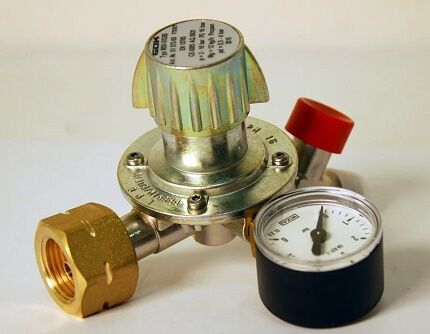
These devices are characterized by some loss of pressure as blue fuel is consumed in the tank with the gas mixture.Therefore, there is an adjusting screw on the body that allows you to adjust the performance characteristics. In order not to make mistakes with the adjustment, such models are equipped with pressure gauges.
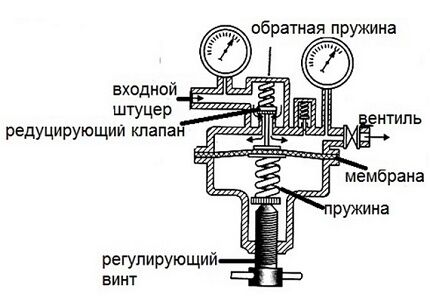
In devices of the third type, for example, TECH CONTROL series OX OR-128 brand Svarog 95255, the reduction and stabilization of pressure characteristics is carried out due to the simultaneous movement of both the valve and the membrane.
The gas flow entering the cavity of the gearbox is held and controlled by a valve on one side, and by a membrane supported by a spring with a transfer disk on the other.
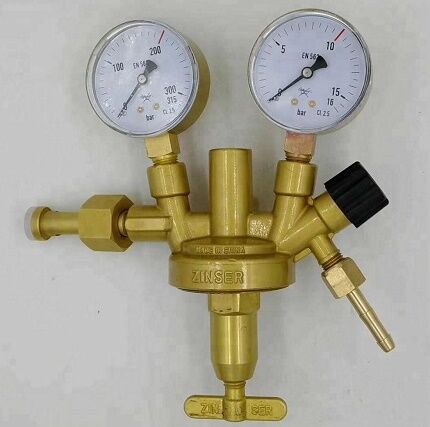
The operation of gearboxes of the third type should be controlled by two pressure gauges placed at the inlet and outlet of the device. They also tend to change the operating pressure at the outlet of the reducer as the gas source empties.
Malfunctions and repair operations
We examined the structure of typical models of gas reducers and made sure that there are no technically complex components in the design. Everything is so elementary that to repair devices it is not at all necessary to contact a gas specialist. Simple repair operations can be easily performed by yourself.
You just need to figure out in advance what to do so that the reducer on the gas cylinder stops humming.
The causes of noise in the reducing device include:
- Deformation and damage to the elastic working element (membrane) of the device, which is often caused by excess pressure of the gas mixture at the outlet of the cylinder or gas tank.
- Incorrect operation. Most often, due to careless and illiterate actions in the process of self-adjustment, the spring or membrane is damaged.
- Preparation for supplying low-quality, poorly purified gas mixture to gas appliances.
Often, in the initial stages of noise appearing in the gearbox, it is enough to simply adjust the factory settings. However, we note that the “frog” is an unregulated device; in any case, it will have to be repaired. Repairs are made by simply replacing damaged parts: a membrane, the end of a bypass valve or a spring.
How to change the membrane?
To replace the membrane, it is better to use a repair kit commercially produced by the gas reducer manufacturer. This elastic element belongs to the abrasive and periodically worn category, which is why manufacturers of expensive gearboxes supply replacement parts for sale.

If you do not have a membrane for your brand of gearbox, then you need to find out the following characteristics:
- Dimensions of the rubber-fabric diaphragm (membrane).
- The thickness of the oiled elastic fabric from which the membrane is made.
- Location of fixation points around the membrane circumference.
The data can be found in the technical documentation for the device or obtained as a result of banal measurements.
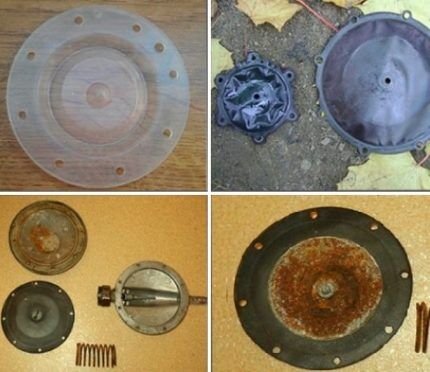
It happens that the sound in the gearbox does not appear due to a broken or deformed membrane, but due to a loss of tightness between it and the housing.
In this case, the gearbox can simply be rebuilt. Before reassembly, the parts of the body in contact with the membrane must be lubricated with sealant, then the components must be connected, ensuring a perfect fit of the diaphragm to the rigid base.
How to fix a reducing spring?
The process of replacing a spring that presses a valve or membrane is no more difficult than installing a new membrane. In the design of gearboxes used in circuits with gas cylinders, reduction springs of the first degree, Ø 15.5, with a number of turns of 12-14 pieces are used.
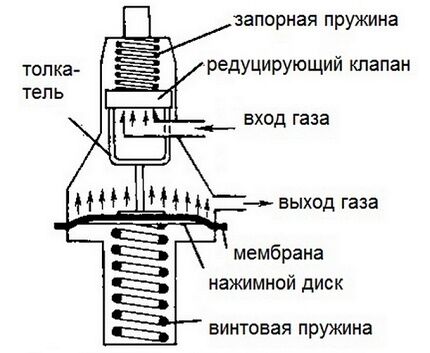
During operation, a spring can simply crack, lose its elasticity and elasticity, and stretch.Due to any of the listed malfunctions, the membrane and inlet valve will not be able to balance their force, i.e. control over the flow of gas into the reducer will be lost.
If the spring breaks, it is replaced with an absolutely similar part. If it is simply stretched somewhat, the problem is solved by installing a gasket. The thickness of this seal is selected based on the situation, measuring the actual distance required for reduction.
How to change the pressure reducing valve?
This work is more serious than previous actions. An important functional part of the gearbox is associated with a control screw, the position of which determines the gas pressure. It is pressed by a spring, which can easily be damaged if too much force is applied.
In addition, the valve may not cope with its duties due to damage or deformation of the end of the tube abutting against it. The movement of the rocker arm may be disrupted, the movement of which is hampered by any displaced or damaged part. Valve malfunctions are also observed due to wear of the gasket.
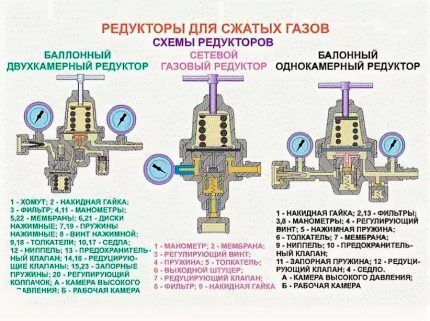
Naturally, to restore the valve's functionality, you will have to disassemble the gearbox housing. Mobility of the rocker is ensured by replacing displaced parts. If necessary, grind the edge that interferes with free movement.
It often happens that all problems in the operation of the valve are associated with just a leaky gasket. Because of it, the elements of the device slightly change their position, but even fractions of millimeters affect the functionality of such a sensitive device.“Cureable” by installing a new gasket.
If the end of the tube is damaged, you just need to sand it. If the tube or rocker arm is seriously damaged, it is better to replace them. Replacement is carried out using repair kits produced for the maintenance and repair of gas fittings.
Conclusions and useful video on the topic
The following video will demonstrate the design and principle of operation of the gearbox for a liquefied gas mixture:
The video will introduce recommendations for choosing a frog-type gearbox:
Video presentation of a propane reducer with a pressure gauge:
It should be remembered that inspection of the technical condition and repair of fittings for gas appliances must be carried out by gas service workers involved in the supply of blue fuel and maintenance of equipment. However, you can handle the simplest operations yourself. This happens, for example, if it is difficult or impossible to call a gas technician to your dacha.
Would you like to tell us how you repaired a gas pressure regulator with your own hands? Do you know the subtleties of the process that can help site visitors? Share them, useful information and photographs on the topic of the article in the block below.



